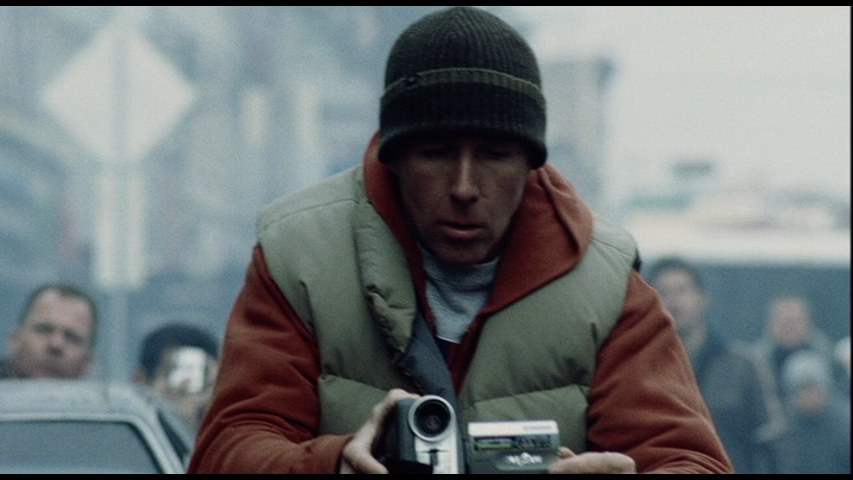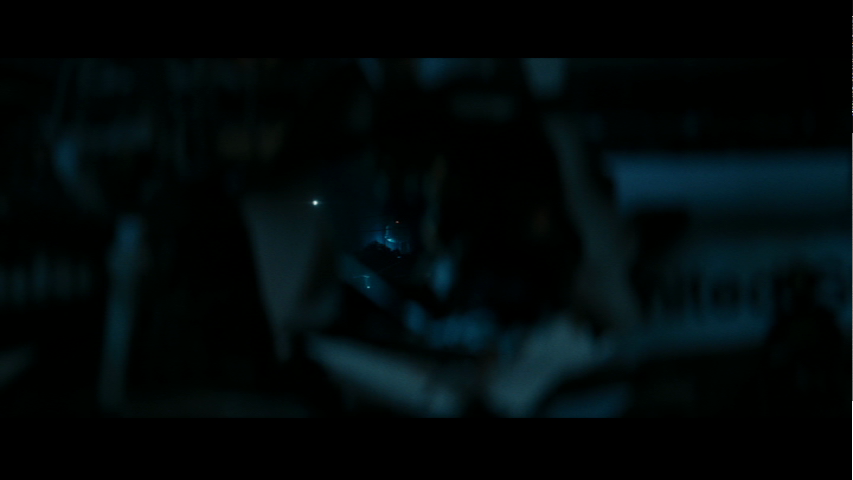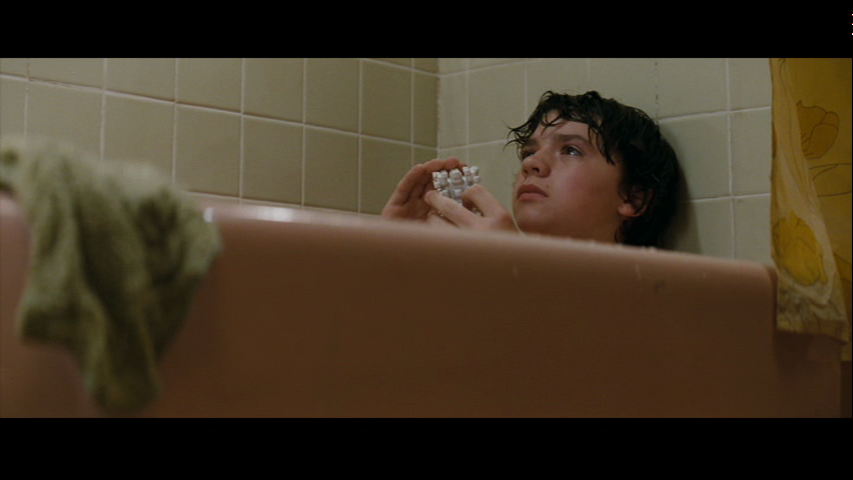(Originally published November 2011 in Media Fields Journal.)
Late in Act II of Jaws (dir. Steven Spielberg, Universal, 1975), with the Orca in hot pursuit of the great white shark, Hooper (Richard Dreyfus) tells Chief Brody (Roy Scheider) to walk out onto the pulpit. He’s taking a picture of the shark and needs “to have something in the foreground to give it some scale.”

Figure 1. Giving It Scale, Jaws

Figure 2. Foreground, Jaws

Figure 3. Chum Some of This, Jaws

Figure 4. Quin’s Actions, Jaws
Flash forward four years, or 36, to 1979 or last summer. Just before the gargantuan train crash that launches us into Act II of Super 8 (dir. J.J. Abrams, Paramount/Amblin/Bad Robot, 2011), onscreen director Charles Kasnyk realizes that he may finally have what he has been looking for: “Production Value!” he screams.

Figure 5. Production Value, Super 8

Figure 6. Automatism, Super 8

Figure 7. Poster, Super 8
Moving along the axis that connects Spielberg (who produced Super 8) to Abrams (who wrote and directed it) allows us to reckon with a group of questions that surround the digital turn. Part of the reason to trace this particular history is that Abrams and Spielberg both consider Abrams’s work to be an extension and elaboration of the project Spielberg began. A second reason, though, lies in the quality of the work itself—not simply that it is itself popular and formally rigorous, but that Spielberg and Abrams’s ability to theorize about the place of their work within the system, indeed, the ability of their production designers, cinematographers, editors, sound editors, effects editors etc., to do the same, makes their films not simply landmarks but nodes around which knowledge clusters in search of further elaboration.
As a first example, let us begin with Jurassic Park (dir. Spielberg, Universal, 1993), a crucial film in the history of digital production. As is usually the case in a Spielberg film, the distinction between what we might call the production narrative and the exhibition narrative collapses. The behind-the-scenes becomes “the scenes” with beneficial effects. In this case the making of Jurassic Park reset the balance of labor in the world of special effects, nearly wiping out model animators in favor of CGI teams at Industrial Light and Magic. Phil Tippett, who had dramatically advanced stop-motion animation technique, was stunned when he saw the first CGI of a hunting T-Rex. The motion was so lifelike, and the scale so believable, he recognized at once that the number of model shots would be slashed. “The change was devastating. I had different concessions…and all of a sudden, the plug was pulled.” Or, as he put it to Spielberg, “I think I’m extinct.” In the film, as Spielberg notes, that was the situation of the paleontologists. “Looks like we’re out of a job,” Dr. Grant says. Malcolm responds, puckishly, “Don’t you mean extinct?” “I kind of rubbed it in by using it in the film itself,” Spielberg grinned.[1] But it remained (on the surface) a joke between friends because Tippett’s animation crew found their way into the CGI process. They still manipulated articulated forms, but they reconceived their product. Instead of producing camera-ready poses, they generated data-points that the CGI animators would then flesh out and render.
Figure 8. CGI Data Points, Jurassic Park
Figure 9. Emblem of Suspense, Jurassic Park
Figure 10. Tippett’s Point of View, Jurassic Park
A decade later, in War of the Worlds, the sideview mirror’s function has been extended.

Figure 11. Sideview Mirror, War of the Worlds
The tripod’s lethal rays begin to operate two scenes earlier, when Ray has gone looking for his own dead car. Like much of War of the Worlds, the scene is both incisive and incoherent. When Ray steps out into the street for a closer look at the tripod, a man is crouching in the foreground with a single use camera.

Figure 12. The Analog, War of the Worlds

Figure 13. The Digital, War of the Worlds

Figure 14. Digital Automatism, War of the Worlds
Once he is vaporized, the camcorder drops to the ground and we witness several evaporations through its viewfinder. The implication seems clear enough: digital capture is the threat; analog photography is a decidedly limited solution, but one the film clings to throughout.
In War of the Worlds the figure for photography is the punctured window. It first appears at the conclusion of a typically Spielbergian game of catch, in which Ray plays the bad dad to the hilt and his son gets his revenge by refusing to catch the ball, allowing it to sail cleanly through the pane behind him.

Figure 15. Spielbergian Catch, War of the Worlds

Figure 16. The Nether Analog, War of the Worlds

Figure 17. Cloacal Maw, War of the Worlds

Figure 18. The Anti-Family Car, War of the Worlds

Figure 19. Oculus I, War of the Worlds

Figure 20. The Photographic Puncture, War of the Worlds
Here, I am again relying on Rodowick’s account of the effects of “digital imaging” on photography. As digital imaging replaces photography, “transcription” is replaced by “digital capture” and “digital synthesis.” The digital “image” then redefines the nature of photography as the automatic recording of perceptually realistic images. In the process, both the time and the space of the image change. Here is Rodowick: “It is as if the creation of digital imaging as a medium were willing the annihilation of past duration with respect to space in order to replace it with another conception of time, that is, the time of calculation or computer cycles.”[3] What Rodowick’s distinction allows us to do is to attach the differences in medium to a particular history, and, to reiterate, the claim I am making is that in these particular projects, that history is consciously being thought through.
That history reaches another inflection point in Abrams’s 2009 Star Trek reboot. There, Kirk is the relay between fascination with analogue, scalar models and digital production values. While troubled manchild Kirk nurses his wounds and considers Pike’s suggestion that he enlist in Starfleet, he casually picks up a starship saltshaker and twiddles it, inspecting its potmetal imperfections and its die-cast residues.
Figure 21. Starship Saltshaker, Star Trek
The teaser trailer had managed the same transition slightly differently. Beginning with Lewis-Hinean shots of welders, it segued into recorded snippets from the glory days of the US space program, fragments with the crushed dynamic range of 1960s transmission and recording technology and long echoes that suggested the vastness of the mission. Leonard Nimoy’s voice then took us through the TV series’ opening—hinting at the importance that “old Spock” would play in the film—as we recognized that our shipwrights have been building the Enterprise. The tagline was simple enough: “Under Construction. Christmas 2008.” (The writers’ strike and Paramount’s near financial collapse delayed the opening until May 2009.) What the film managed through Kirk’s gaze, the trailer accomplished through Spock’s voice: the trailer erects an analogy between the real and the fictional space programs so smooth that it barely functions as analogy anymore. It seems, in short, to be history, and as history, that suffusing analogy promises to heal the breach occasioned by the loss of the analog.
This last claim may seem so much misplaced emotion in the guise of a medium specific account. For the form of the claim—that a higher level, conscious, production-centered analogy replaces the analogue—I am simply abusing another formulation of Rodowick’s: “The criteria of perceptual realism are defined by analogy with photographic images without themselves relying on analogical processes.”[4] But for my conviction that this structure undergirds Super 8, I am relying, finally, on Abrams himself. This is how he described the situation to The Guardian:
I’m obsessed with things that are distinctly analogue. We have a letterpress in our office. There’s an absolute wonderful imperfection that you get when you do a letterpress, and that is the beauty of it. The time that is put in setting the type and running the press, inking the rollers, all that stuff – that kind of thing is clearly an extreme example. But it’s the beauty of the actual investment of time, and the amount of time that goes by lets you consider things that somehow, in a kind of weird osmosis or spiritual way, is somehow implicit in the final product. And that seems to not exist much any more.[5]
Abrams makes clear that digital pressure threatens not simply analogue filmmaking, but filmmaking that self-consciously figures its own systemic importance.
There are, according to the film, two model-builders in Super 8. One is Joe, who builds in his room, working from kits. He has been working on model trains, which are critically about their scales.

Figure 22. Model Trains, Super 8

Figure 23. Digicubes, Super 8

Figure 24. Digicube Array, Super 8
The link between Joe’s model and the alien’s appears when the digicube becomes restless and, eventually, shoots through the wall of his bedroom toward the water tower in the distance.

Figure 25. Through the Bedroom Wall, Super 8

Figure 26. Digital Puncture, Super 8

Figure 27. Cubes and Tiles, Super 8
The kids refer to these things as “white Rubik’s cubes” a handy description that is both anachronistic—the Rubik’s cube came out the next year—and baffling: what would be the point of a white Rubik’s cube? It is not a puzzle since it has no solution. As an object of nearly limitless combinations, it suggests the essentially abstract and mathematical nature of digital imaging: a vast collection of combinations. At the same time, as a Rubik’s cube, it suggests an inherent manipulability, something we see in this masturbatory image. (The cube was a gift from Joe’s girlfriend, Alice.) And with that suggestion, we return to the notion that analogy takes the place of the analog. Where Charles wants to blow up scale and replace it with production value, Joe and Alice understand that when the digital becomes manipulable, it offers the possibility of descaling.
Super 8 opens with a shot of the interior of the “Employee Owned” Lillian Steel mill centered on a sign that declares that the facility has been accident-free for 784 days. As the camera pushes in on the sign, a hard-hatted worker rises on a scissor lift, removes the decidedly analog numbers, and replaces them with 1.
It is a piece of high Spielbergian family drama, with its distant father/ingenuous son dynamic. And while it seems a world away from the opening shot, it is actually a version of it. Like the hard-hatted worker, Jack is going to have to “step up” and focus on his son. That story, as Super 8 tells it, is fairly rudimentary, it has a nadir—when Jack explains that he is sending Joe to baseball camp for the summer—and it culminates in a remarkable fight.
Descaling, at the mill and at the Lamb’s house, is a way of reasserting the essential balance between the obligations of one’s work and family, or of one’s labor and one’s love, now channeled through the work of and a rivalry with, a paternal director. Let’s take this last notion a step further. Joe’s aggressive assertion of dependence is what is required to force his dad to recognize his own obligations. And understood affectively, it threatens to plunge us into a dead-end “anxiety of influence” reading of the film. Abrams, characteristically canny, explained why he did not think that was the proper model.
“The initial conceit was not ‘do a Spielbergian movie,'” Abrams says. “I didn’t think: ‘Oh, let’s start ripping off other Spielberg films.’ It was just: ‘This is a story that could be cool.’ “I’d called a guy who had a production company called Amblin, who made a bunch of movies that I loved [when I was] growing up and still love now, and when you’re working with someone who inspires you in a certain way, that’s part of the fun of it. “Super 8 is about kids in 1979 who are the age that I was at that time, and I was massively influenced by Steven’s films. What made perfect sense was not: ‘OK, let’s ape his movies and start copying things,’ but let’s make a movie that feels like it belongs on a shelf with other Amblin movies. “It was a spirit, not a scene, that I was trying to emulate. It felt like: ‘This is what the movie wants to be.’ I would actually say that because I was doing it with Steven, I felt entirely liberated to embrace that kind of stuff. I never would have made this movie this way, I’m certain, had he not been a producer.”[6]
On the one hand, this assertion of corporate allegiance merely expands the field of potential thefts to include the work of Robert Zemeckis and Joe Dante. But on the other hand, it is an assertion of utopian collective aesthetic production. The film can be Abrams’s because it is a corporate property. Had it been made outside of Amblin, Super 8 would be a ripoff or an homage; inside it is an aspirational aesthetic object. It wants to sit on the shelf; “this is what the movie wants to be.” By 2011, the distance between digital imaging and scalar modeling seems too great to be stably mediated by an individual body, even the body of the auteur. In his place, we find an employee-owned corporation, a fantasy of a studio.
Notes
[1] “The Making of Jurassic Park,” Jurassic Park, directed by Steven Spielberg (1993; Universal Studios Home Entertainment, 2010), DVD.
[2] Rodowick, The Virtual Life of Film, Cambridge, MA: Harvard UP, 2007, 122.
[3] Ibid., 104.
[4] Ibid.
[5] Katie Puckrick, “J.J. Abrams: ‘I called Spielberg and he said yes,” The Guardian, 8/1/11, http://www.guardian.co.uk/film/2011/aug/01/jj-abrams-spielberg-super-8.
[6] Ibid.
